Black Scholes Model and Warren Buffet's Argument
VerifiedAdded on 2023/05/31
|6
|1731
|317
AI Summary
This report discusses the argument put forward by Warren Buffet that Black Scholes model gives incorrect valuation for options with longer maturities. It also analyzes the mathematical terminology proposed by him and the validity of his argument. The report concludes by mentioning the different strategies used by Warren Buffet to make money.
Contribute Materials
Your contribution can guide someone’s learning journey. Share your
documents today.
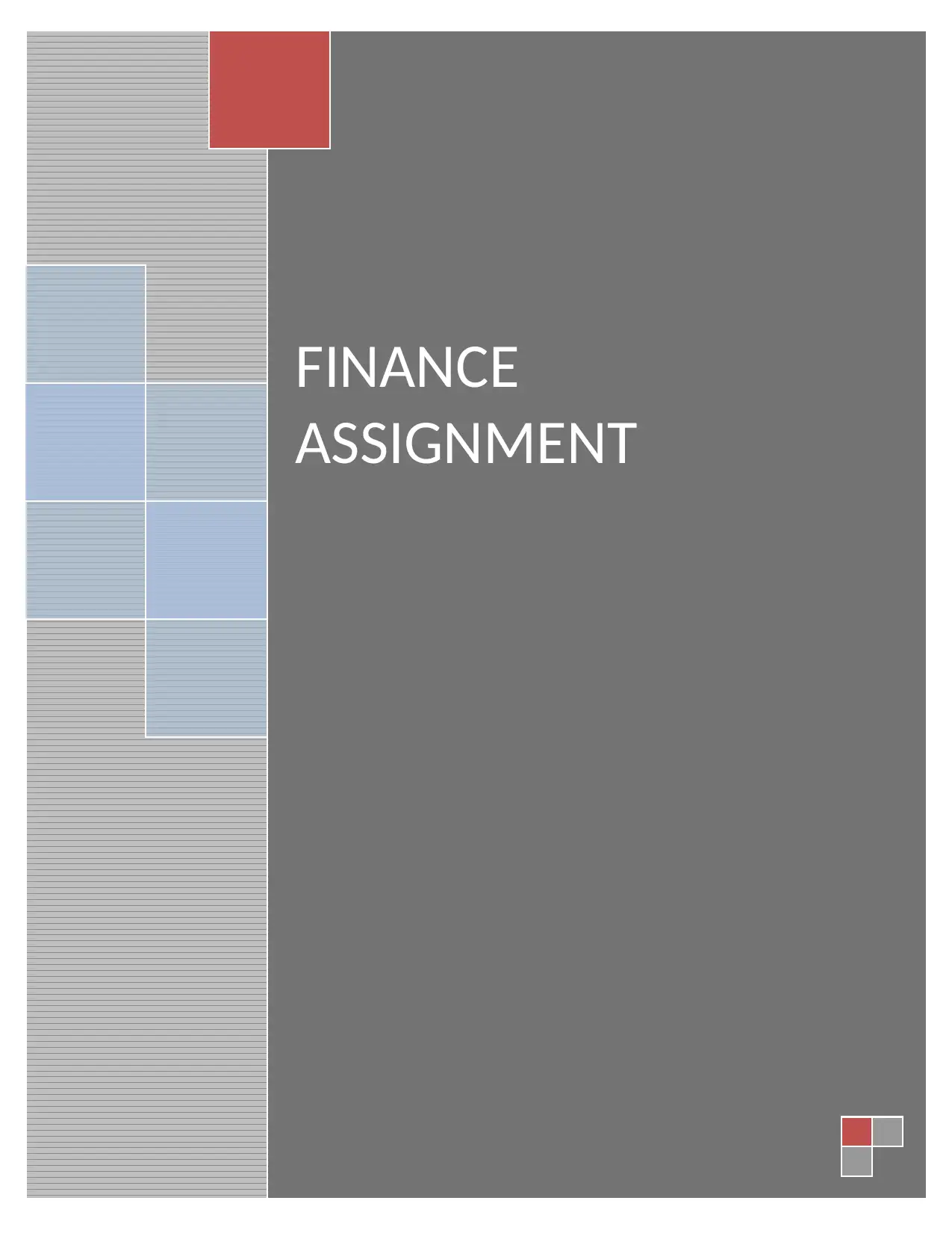
FINANCE
ASSIGNMENT
ASSIGNMENT
Secure Best Marks with AI Grader
Need help grading? Try our AI Grader for instant feedback on your assignments.
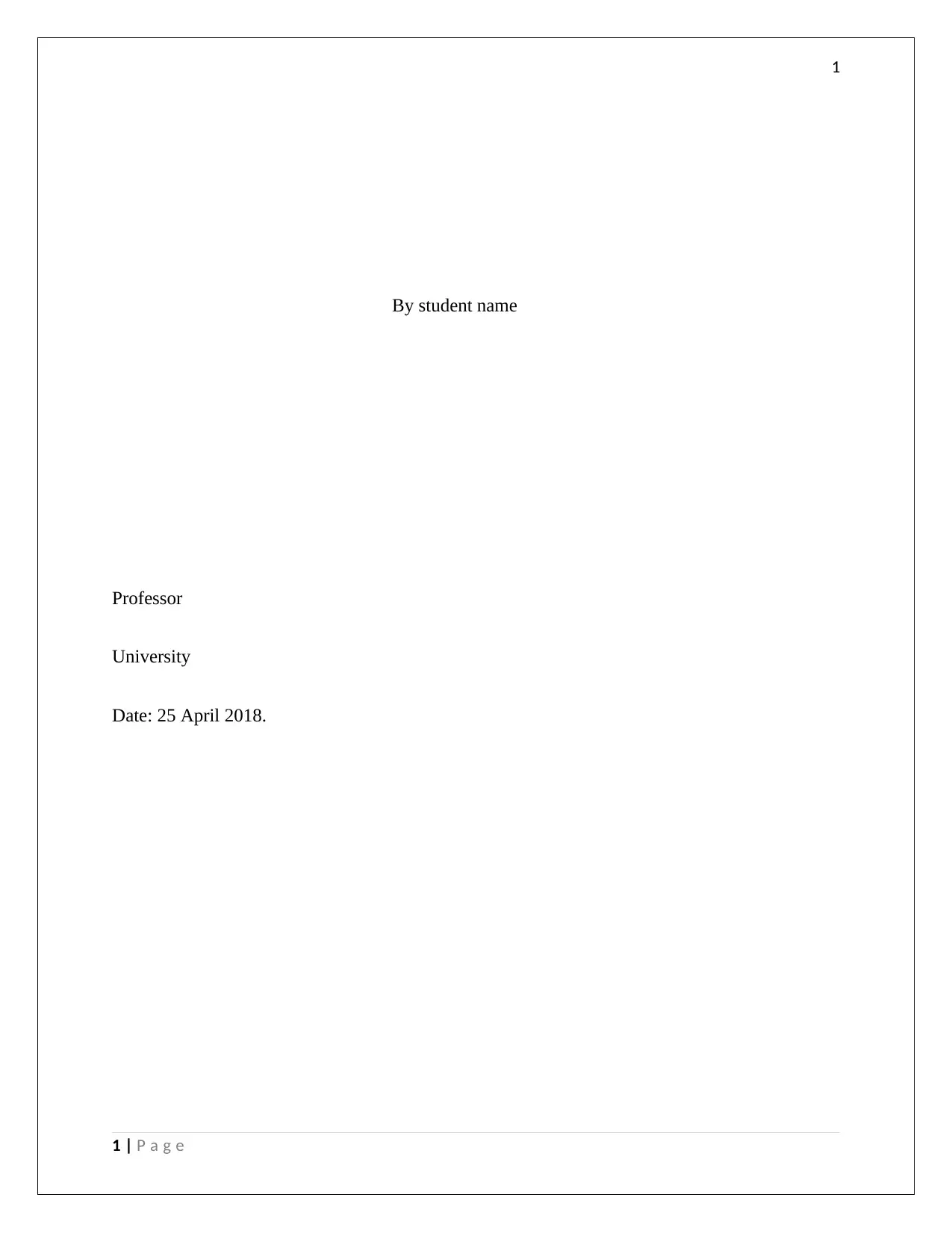
1
By student name
Professor
University
Date: 25 April 2018.
1 | P a g e
By student name
Professor
University
Date: 25 April 2018.
1 | P a g e
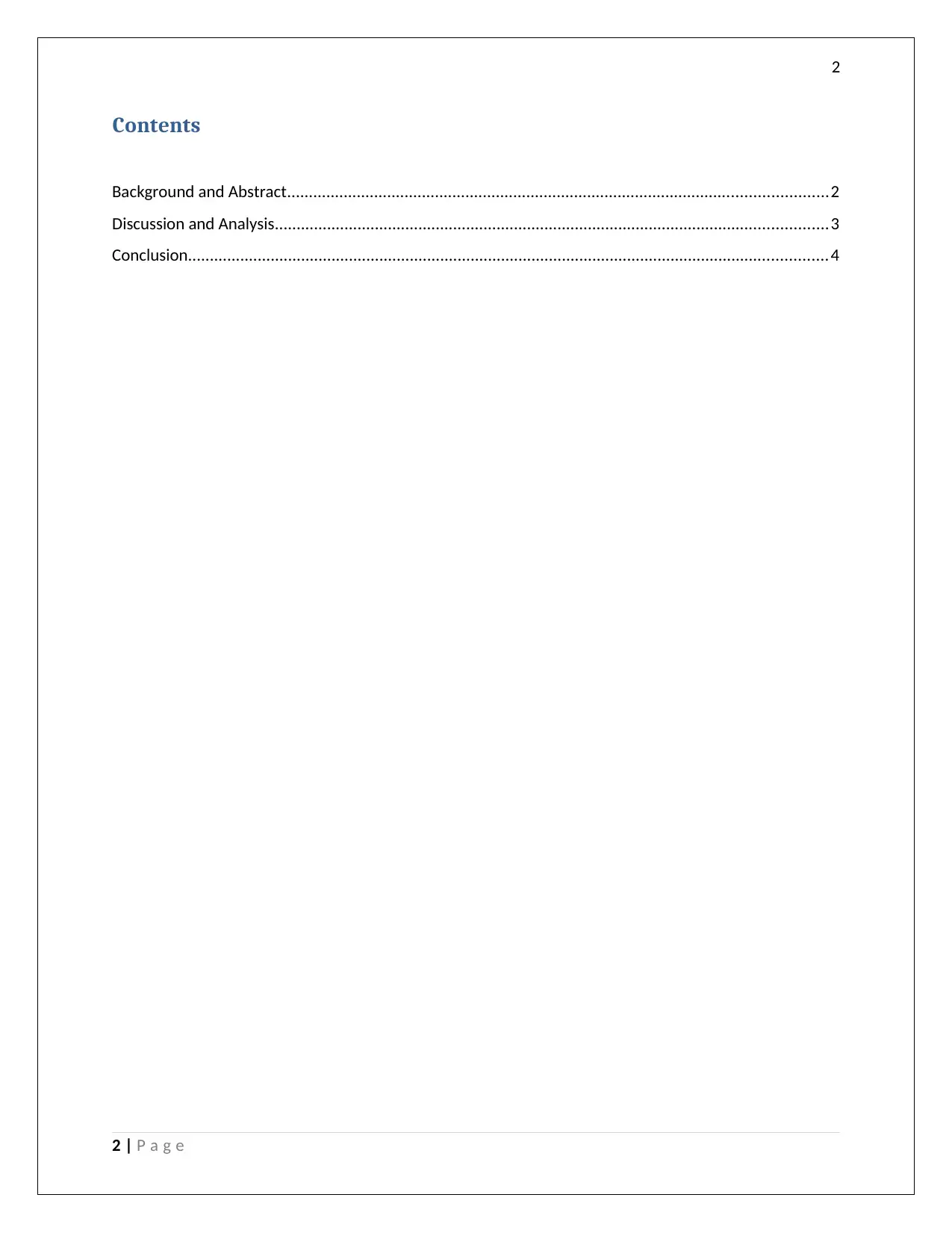
2
Contents
Background and Abstract............................................................................................................................2
Discussion and Analysis...............................................................................................................................3
Conclusion...................................................................................................................................................4
2 | P a g e
Contents
Background and Abstract............................................................................................................................2
Discussion and Analysis...............................................................................................................................3
Conclusion...................................................................................................................................................4
2 | P a g e
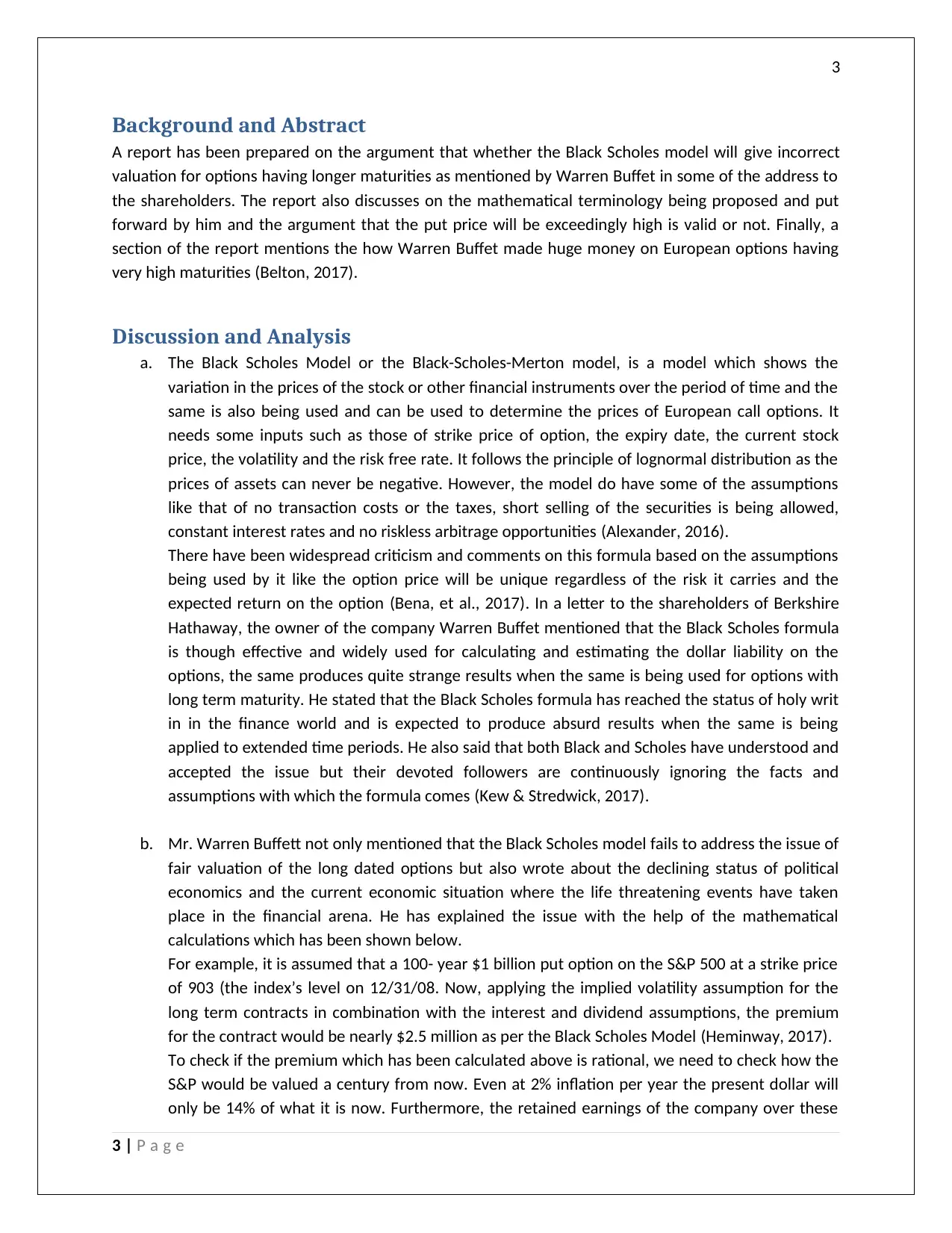
3
Background and Abstract
A report has been prepared on the argument that whether the Black Scholes model will give incorrect
valuation for options having longer maturities as mentioned by Warren Buffet in some of the address to
the shareholders. The report also discusses on the mathematical terminology being proposed and put
forward by him and the argument that the put price will be exceedingly high is valid or not. Finally, a
section of the report mentions the how Warren Buffet made huge money on European options having
very high maturities (Belton, 2017).
Discussion and Analysis
a. The Black Scholes Model or the Black-Scholes-Merton model, is a model which shows the
variation in the prices of the stock or other financial instruments over the period of time and the
same is also being used and can be used to determine the prices of European call options. It
needs some inputs such as those of strike price of option, the expiry date, the current stock
price, the volatility and the risk free rate. It follows the principle of lognormal distribution as the
prices of assets can never be negative. However, the model do have some of the assumptions
like that of no transaction costs or the taxes, short selling of the securities is being allowed,
constant interest rates and no riskless arbitrage opportunities (Alexander, 2016).
There have been widespread criticism and comments on this formula based on the assumptions
being used by it like the option price will be unique regardless of the risk it carries and the
expected return on the option (Bena, et al., 2017). In a letter to the shareholders of Berkshire
Hathaway, the owner of the company Warren Buffet mentioned that the Black Scholes formula
is though effective and widely used for calculating and estimating the dollar liability on the
options, the same produces quite strange results when the same is being used for options with
long term maturity. He stated that the Black Scholes formula has reached the status of holy writ
in in the finance world and is expected to produce absurd results when the same is being
applied to extended time periods. He also said that both Black and Scholes have understood and
accepted the issue but their devoted followers are continuously ignoring the facts and
assumptions with which the formula comes (Kew & Stredwick, 2017).
b. Mr. Warren Buffett not only mentioned that the Black Scholes model fails to address the issue of
fair valuation of the long dated options but also wrote about the declining status of political
economics and the current economic situation where the life threatening events have taken
place in the financial arena. He has explained the issue with the help of the mathematical
calculations which has been shown below.
For example, it is assumed that a 100- year $1 billion put option on the S&P 500 at a strike price
of 903 (the index’s level on 12/31/08. Now, applying the implied volatility assumption for the
long term contracts in combination with the interest and dividend assumptions, the premium
for the contract would be nearly $2.5 million as per the Black Scholes Model (Heminway, 2017).
To check if the premium which has been calculated above is rational, we need to check how the
S&P would be valued a century from now. Even at 2% inflation per year the present dollar will
only be 14% of what it is now. Furthermore, the retained earnings of the company over these
3 | P a g e
Background and Abstract
A report has been prepared on the argument that whether the Black Scholes model will give incorrect
valuation for options having longer maturities as mentioned by Warren Buffet in some of the address to
the shareholders. The report also discusses on the mathematical terminology being proposed and put
forward by him and the argument that the put price will be exceedingly high is valid or not. Finally, a
section of the report mentions the how Warren Buffet made huge money on European options having
very high maturities (Belton, 2017).
Discussion and Analysis
a. The Black Scholes Model or the Black-Scholes-Merton model, is a model which shows the
variation in the prices of the stock or other financial instruments over the period of time and the
same is also being used and can be used to determine the prices of European call options. It
needs some inputs such as those of strike price of option, the expiry date, the current stock
price, the volatility and the risk free rate. It follows the principle of lognormal distribution as the
prices of assets can never be negative. However, the model do have some of the assumptions
like that of no transaction costs or the taxes, short selling of the securities is being allowed,
constant interest rates and no riskless arbitrage opportunities (Alexander, 2016).
There have been widespread criticism and comments on this formula based on the assumptions
being used by it like the option price will be unique regardless of the risk it carries and the
expected return on the option (Bena, et al., 2017). In a letter to the shareholders of Berkshire
Hathaway, the owner of the company Warren Buffet mentioned that the Black Scholes formula
is though effective and widely used for calculating and estimating the dollar liability on the
options, the same produces quite strange results when the same is being used for options with
long term maturity. He stated that the Black Scholes formula has reached the status of holy writ
in in the finance world and is expected to produce absurd results when the same is being
applied to extended time periods. He also said that both Black and Scholes have understood and
accepted the issue but their devoted followers are continuously ignoring the facts and
assumptions with which the formula comes (Kew & Stredwick, 2017).
b. Mr. Warren Buffett not only mentioned that the Black Scholes model fails to address the issue of
fair valuation of the long dated options but also wrote about the declining status of political
economics and the current economic situation where the life threatening events have taken
place in the financial arena. He has explained the issue with the help of the mathematical
calculations which has been shown below.
For example, it is assumed that a 100- year $1 billion put option on the S&P 500 at a strike price
of 903 (the index’s level on 12/31/08. Now, applying the implied volatility assumption for the
long term contracts in combination with the interest and dividend assumptions, the premium
for the contract would be nearly $2.5 million as per the Black Scholes Model (Heminway, 2017).
To check if the premium which has been calculated above is rational, we need to check how the
S&P would be valued a century from now. Even at 2% inflation per year the present dollar will
only be 14% of what it is now. Furthermore, the retained earnings of the company over these
3 | P a g e
Secure Best Marks with AI Grader
Need help grading? Try our AI Grader for instant feedback on your assignments.
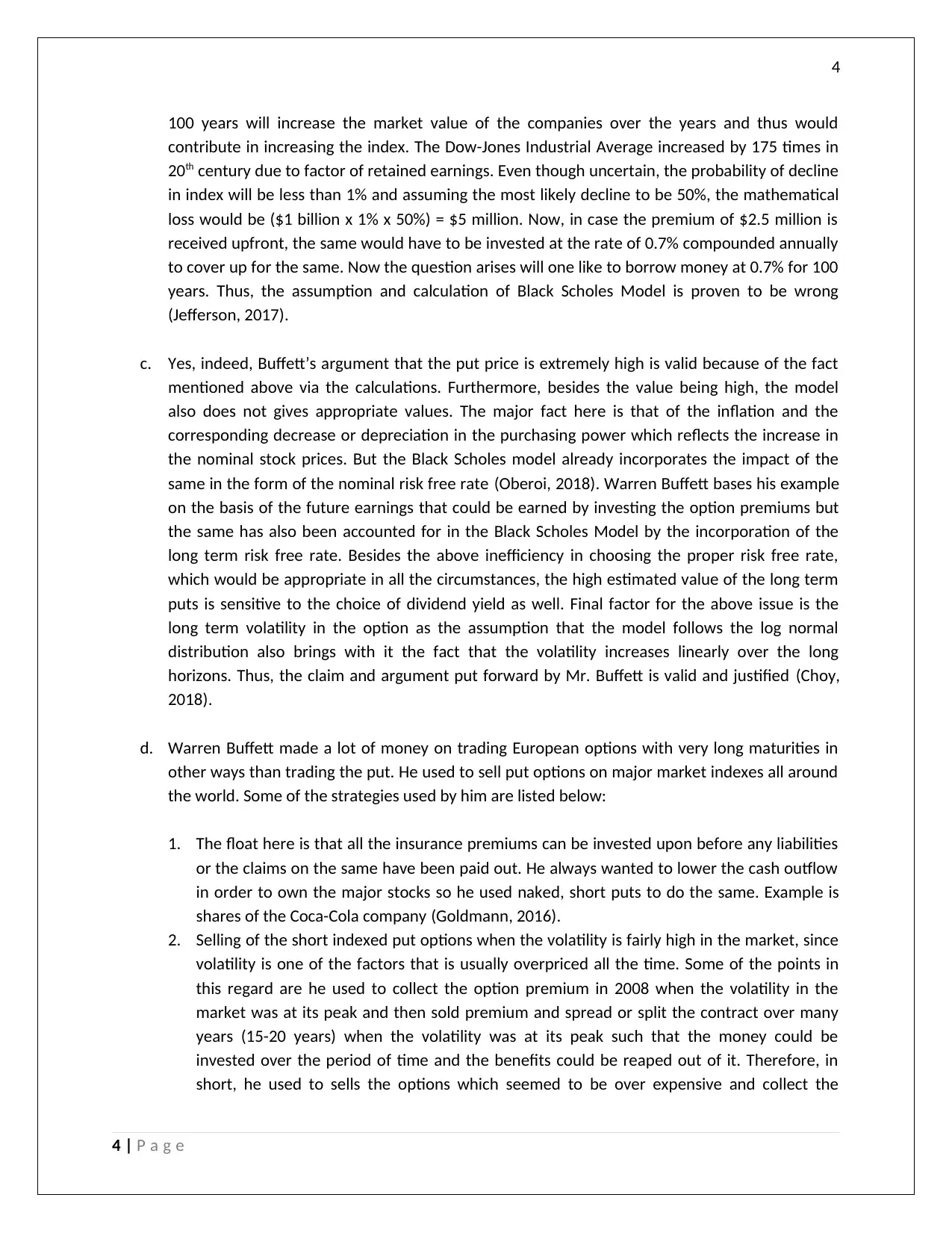
4
100 years will increase the market value of the companies over the years and thus would
contribute in increasing the index. The Dow-Jones Industrial Average increased by 175 times in
20th century due to factor of retained earnings. Even though uncertain, the probability of decline
in index will be less than 1% and assuming the most likely decline to be 50%, the mathematical
loss would be ($1 billion x 1% x 50%) = $5 million. Now, in case the premium of $2.5 million is
received upfront, the same would have to be invested at the rate of 0.7% compounded annually
to cover up for the same. Now the question arises will one like to borrow money at 0.7% for 100
years. Thus, the assumption and calculation of Black Scholes Model is proven to be wrong
(Jefferson, 2017).
c. Yes, indeed, Buffett’s argument that the put price is extremely high is valid because of the fact
mentioned above via the calculations. Furthermore, besides the value being high, the model
also does not gives appropriate values. The major fact here is that of the inflation and the
corresponding decrease or depreciation in the purchasing power which reflects the increase in
the nominal stock prices. But the Black Scholes model already incorporates the impact of the
same in the form of the nominal risk free rate (Oberoi, 2018). Warren Buffett bases his example
on the basis of the future earnings that could be earned by investing the option premiums but
the same has also been accounted for in the Black Scholes Model by the incorporation of the
long term risk free rate. Besides the above inefficiency in choosing the proper risk free rate,
which would be appropriate in all the circumstances, the high estimated value of the long term
puts is sensitive to the choice of dividend yield as well. Final factor for the above issue is the
long term volatility in the option as the assumption that the model follows the log normal
distribution also brings with it the fact that the volatility increases linearly over the long
horizons. Thus, the claim and argument put forward by Mr. Buffett is valid and justified (Choy,
2018).
d. Warren Buffett made a lot of money on trading European options with very long maturities in
other ways than trading the put. He used to sell put options on major market indexes all around
the world. Some of the strategies used by him are listed below:
1. The float here is that all the insurance premiums can be invested upon before any liabilities
or the claims on the same have been paid out. He always wanted to lower the cash outflow
in order to own the major stocks so he used naked, short puts to do the same. Example is
shares of the Coca-Cola company (Goldmann, 2016).
2. Selling of the short indexed put options when the volatility is fairly high in the market, since
volatility is one of the factors that is usually overpriced all the time. Some of the points in
this regard are he used to collect the option premium in 2008 when the volatility in the
market was at its peak and then sold premium and spread or split the contract over many
years (15-20 years) when the volatility was at its peak such that the money could be
invested over the period of time and the benefits could be reaped out of it. Therefore, in
short, he used to sells the options which seemed to be over expensive and collect the
4 | P a g e
100 years will increase the market value of the companies over the years and thus would
contribute in increasing the index. The Dow-Jones Industrial Average increased by 175 times in
20th century due to factor of retained earnings. Even though uncertain, the probability of decline
in index will be less than 1% and assuming the most likely decline to be 50%, the mathematical
loss would be ($1 billion x 1% x 50%) = $5 million. Now, in case the premium of $2.5 million is
received upfront, the same would have to be invested at the rate of 0.7% compounded annually
to cover up for the same. Now the question arises will one like to borrow money at 0.7% for 100
years. Thus, the assumption and calculation of Black Scholes Model is proven to be wrong
(Jefferson, 2017).
c. Yes, indeed, Buffett’s argument that the put price is extremely high is valid because of the fact
mentioned above via the calculations. Furthermore, besides the value being high, the model
also does not gives appropriate values. The major fact here is that of the inflation and the
corresponding decrease or depreciation in the purchasing power which reflects the increase in
the nominal stock prices. But the Black Scholes model already incorporates the impact of the
same in the form of the nominal risk free rate (Oberoi, 2018). Warren Buffett bases his example
on the basis of the future earnings that could be earned by investing the option premiums but
the same has also been accounted for in the Black Scholes Model by the incorporation of the
long term risk free rate. Besides the above inefficiency in choosing the proper risk free rate,
which would be appropriate in all the circumstances, the high estimated value of the long term
puts is sensitive to the choice of dividend yield as well. Final factor for the above issue is the
long term volatility in the option as the assumption that the model follows the log normal
distribution also brings with it the fact that the volatility increases linearly over the long
horizons. Thus, the claim and argument put forward by Mr. Buffett is valid and justified (Choy,
2018).
d. Warren Buffett made a lot of money on trading European options with very long maturities in
other ways than trading the put. He used to sell put options on major market indexes all around
the world. Some of the strategies used by him are listed below:
1. The float here is that all the insurance premiums can be invested upon before any liabilities
or the claims on the same have been paid out. He always wanted to lower the cash outflow
in order to own the major stocks so he used naked, short puts to do the same. Example is
shares of the Coca-Cola company (Goldmann, 2016).
2. Selling of the short indexed put options when the volatility is fairly high in the market, since
volatility is one of the factors that is usually overpriced all the time. Some of the points in
this regard are he used to collect the option premium in 2008 when the volatility in the
market was at its peak and then sold premium and spread or split the contract over many
years (15-20 years) when the volatility was at its peak such that the money could be
invested over the period of time and the benefits could be reaped out of it. Therefore, in
short, he used to sells the options which seemed to be over expensive and collect the
4 | P a g e
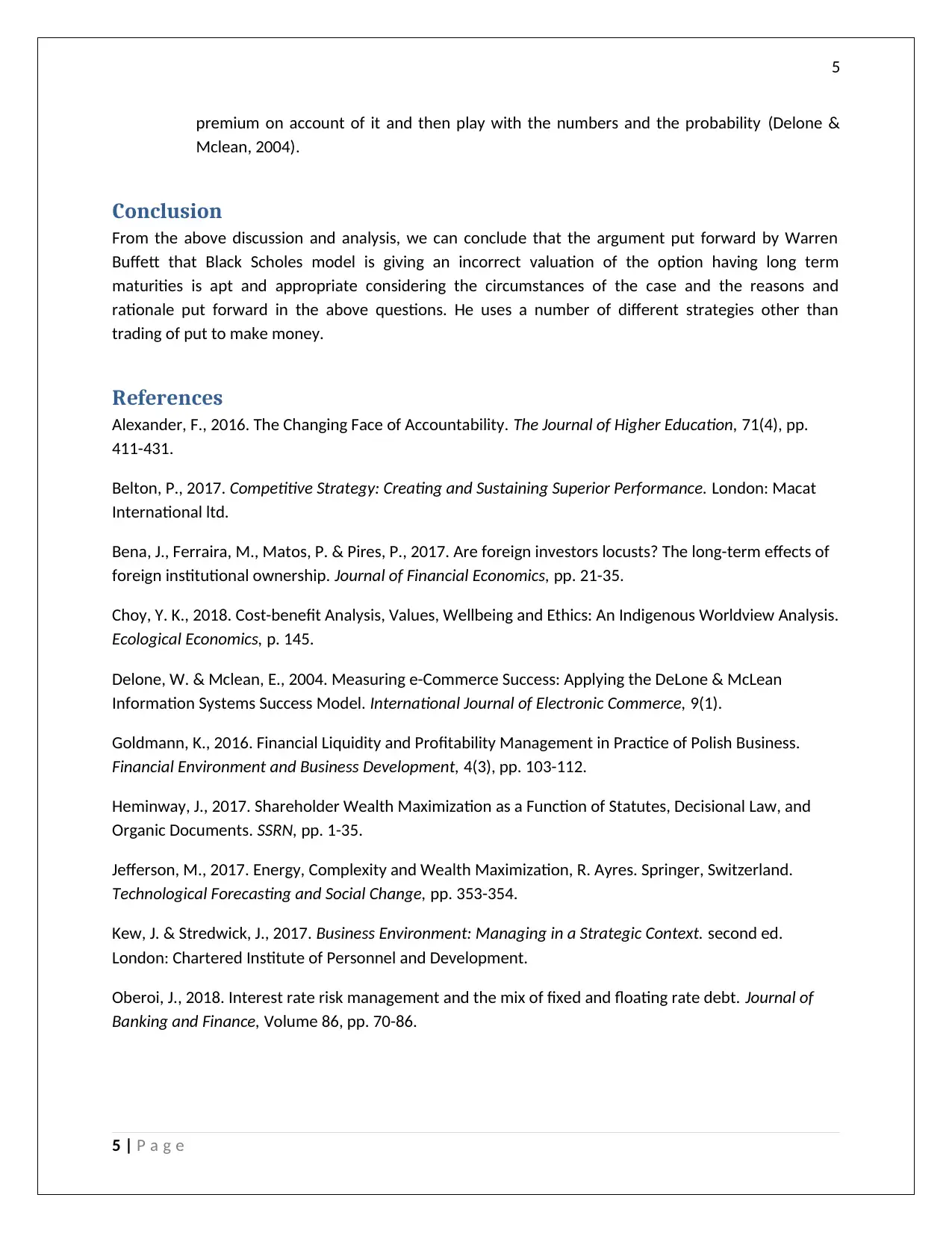
5
premium on account of it and then play with the numbers and the probability (Delone &
Mclean, 2004).
Conclusion
From the above discussion and analysis, we can conclude that the argument put forward by Warren
Buffett that Black Scholes model is giving an incorrect valuation of the option having long term
maturities is apt and appropriate considering the circumstances of the case and the reasons and
rationale put forward in the above questions. He uses a number of different strategies other than
trading of put to make money.
References
Alexander, F., 2016. The Changing Face of Accountability. The Journal of Higher Education, 71(4), pp.
411-431.
Belton, P., 2017. Competitive Strategy: Creating and Sustaining Superior Performance. London: Macat
International ltd.
Bena, J., Ferraira, M., Matos, P. & Pires, P., 2017. Are foreign investors locusts? The long-term effects of
foreign institutional ownership. Journal of Financial Economics, pp. 21-35.
Choy, Y. K., 2018. Cost-benefit Analysis, Values, Wellbeing and Ethics: An Indigenous Worldview Analysis.
Ecological Economics, p. 145.
Delone, W. & Mclean, E., 2004. Measuring e-Commerce Success: Applying the DeLone & McLean
Information Systems Success Model. International Journal of Electronic Commerce, 9(1).
Goldmann, K., 2016. Financial Liquidity and Profitability Management in Practice of Polish Business.
Financial Environment and Business Development, 4(3), pp. 103-112.
Heminway, J., 2017. Shareholder Wealth Maximization as a Function of Statutes, Decisional Law, and
Organic Documents. SSRN, pp. 1-35.
Jefferson, M., 2017. Energy, Complexity and Wealth Maximization, R. Ayres. Springer, Switzerland.
Technological Forecasting and Social Change, pp. 353-354.
Kew, J. & Stredwick, J., 2017. Business Environment: Managing in a Strategic Context. second ed.
London: Chartered Institute of Personnel and Development.
Oberoi, J., 2018. Interest rate risk management and the mix of fixed and floating rate debt. Journal of
Banking and Finance, Volume 86, pp. 70-86.
5 | P a g e
premium on account of it and then play with the numbers and the probability (Delone &
Mclean, 2004).
Conclusion
From the above discussion and analysis, we can conclude that the argument put forward by Warren
Buffett that Black Scholes model is giving an incorrect valuation of the option having long term
maturities is apt and appropriate considering the circumstances of the case and the reasons and
rationale put forward in the above questions. He uses a number of different strategies other than
trading of put to make money.
References
Alexander, F., 2016. The Changing Face of Accountability. The Journal of Higher Education, 71(4), pp.
411-431.
Belton, P., 2017. Competitive Strategy: Creating and Sustaining Superior Performance. London: Macat
International ltd.
Bena, J., Ferraira, M., Matos, P. & Pires, P., 2017. Are foreign investors locusts? The long-term effects of
foreign institutional ownership. Journal of Financial Economics, pp. 21-35.
Choy, Y. K., 2018. Cost-benefit Analysis, Values, Wellbeing and Ethics: An Indigenous Worldview Analysis.
Ecological Economics, p. 145.
Delone, W. & Mclean, E., 2004. Measuring e-Commerce Success: Applying the DeLone & McLean
Information Systems Success Model. International Journal of Electronic Commerce, 9(1).
Goldmann, K., 2016. Financial Liquidity and Profitability Management in Practice of Polish Business.
Financial Environment and Business Development, 4(3), pp. 103-112.
Heminway, J., 2017. Shareholder Wealth Maximization as a Function of Statutes, Decisional Law, and
Organic Documents. SSRN, pp. 1-35.
Jefferson, M., 2017. Energy, Complexity and Wealth Maximization, R. Ayres. Springer, Switzerland.
Technological Forecasting and Social Change, pp. 353-354.
Kew, J. & Stredwick, J., 2017. Business Environment: Managing in a Strategic Context. second ed.
London: Chartered Institute of Personnel and Development.
Oberoi, J., 2018. Interest rate risk management and the mix of fixed and floating rate debt. Journal of
Banking and Finance, Volume 86, pp. 70-86.
5 | P a g e
1 out of 6
Your All-in-One AI-Powered Toolkit for Academic Success.
+13062052269
info@desklib.com
Available 24*7 on WhatsApp / Email
![[object Object]](/_next/static/media/star-bottom.7253800d.svg)
Unlock your academic potential
© 2024 | Zucol Services PVT LTD | All rights reserved.


